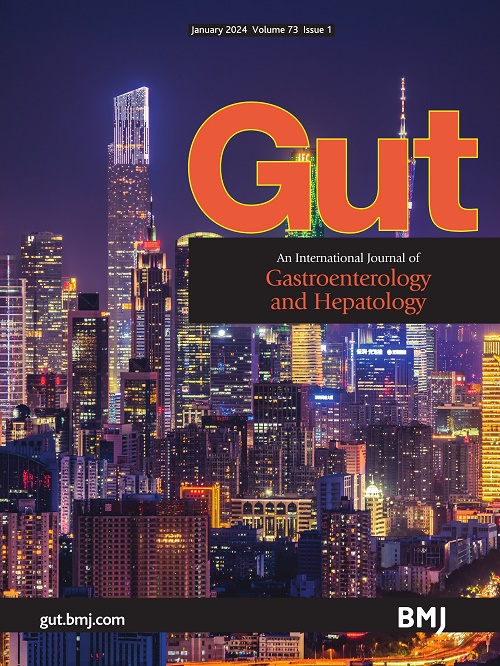Pericyte drives the formation of circulating tumour cell-neutrophil clusters to promote colorectal cancer metastasis.
IF 25.8
1区 医学
Q1 GASTROENTEROLOGY & HEPATOLOGY
引用次数: 0
Abstract
BACKGROUND Circulating tumour cell (CTC)-neutrophil clusters represent a key driver and a hallmark of tumour metastasis; however, efficient approaches for their elimination are still lacking. OBJECTIVE This study sought to elucidate the location and mechanisms of CTC-neutrophil cluster formation and develop more effective antimetastasis strategies. DESIGN Immunofluorescence staining of clinical colorectal cancer (CRC) samples was performed to identify the location of CTC-neutrophil clusters. The correlation between the expression of nicotinamide N-methyltransferase (NNMT) in pericytes and patient prognosis, as well as its association with CTC-neutrophil cluster formation, was assessed using clinical specimens and public CRC datasets. The formation process of CTC-neutrophil clusters was visualised using intravital microscope and microfluidic vascular chip models. Bulk RNA sequencing, xenograft and allograft models and pericyte-specific genetic Nnmt deficiency mice were used to investigate the effect of pericyte NNMT on CTC-neutrophil cluster formation and CRC metastasis. RESULTS CTC-neutrophil clusters formed at the vascular-immune interface of CRC primary tumours. Pericytes with high NNMT expression could serve as a poor prognostic biomarker that indicated an increased risk of developing metastasis in CRC. NNMT highly NNMT-expressing pericytes facilitated the formation of CTC-neutrophil clusters by mediating the cellular interaction among CRC cells, neutrophils and endothelial cells through activating the CXCL5/CXCR2 axis. Genetic and pharmacological inhibition of NNMT in pericytes eliminated CTC-neutrophil clusters and suppressed CRC liver metastasis. CONCLUSION This study uncovers the previously undefined location and mechanism of CTC-neutrophil cluster formation and underscores the potential of pericyte-driven CTC-neutrophil clusters as a valuable prognostic indicator and therapeutic target for CRC metastasis.周细胞驱动循环肿瘤细胞中性粒细胞团簇的形成,促进结直肠癌转移。
背景:循环肿瘤细胞(CTC)-中性粒细胞集群是肿瘤转移的关键驱动因素和标志;然而,仍然缺乏有效的消除方法。目的研究ctc -中性粒细胞簇形成的位置和机制,寻求更有效的抗转移策略。设计对临床结直肠癌(CRC)样本进行免疫荧光染色,以确定ctc -中性粒细胞簇的位置。使用临床标本和公共CRC数据集评估了周细胞中烟酰胺n -甲基转移酶(NNMT)表达与患者预后的关系,以及它与ctc中性粒细胞簇形成的关系。采用活体显微镜和微流控血管芯片模型观察ctc -中性粒细胞团簇的形成过程。采用大量RNA测序、异种移植和同种异体移植模型以及周细胞特异性遗传Nnmt缺乏小鼠,研究周细胞Nnmt对ctc -中性粒细胞簇形成和结直肠癌转移的影响。结果CRC原发肿瘤的血管-免疫界面形成sctc -中性粒细胞团簇。高表达NNMT的周细胞可作为预后不良的生物标志物,提示结直肠癌发生转移的风险增加。NNMT高表达NNMT的周细胞通过激活CXCL5/CXCR2轴介导CRC细胞、中性粒细胞和内皮细胞之间的相互作用,促进ctc -中性粒细胞团簇的形成。遗传和药理抑制NNMT在周细胞消除ctc中性粒细胞簇和抑制结直肠癌肝转移。结论本研究揭示了以前未明确的ctc -中性粒细胞簇形成的位置和机制,并强调了周细胞驱动的ctc -中性粒细胞簇作为结直肠癌转移的有价值的预后指标和治疗靶点的潜力。
本文章由计算机程序翻译,如有差异,请以英文原文为准。
求助全文
约1分钟内获得全文
求助全文
来源期刊

Gut
医学-胃肠肝病学
CiteScore
45.70
自引率
2.40%
发文量
284
审稿时长
1.5 months
期刊介绍:
Gut is a renowned international journal specializing in gastroenterology and hepatology, known for its high-quality clinical research covering the alimentary tract, liver, biliary tree, and pancreas. It offers authoritative and current coverage across all aspects of gastroenterology and hepatology, featuring articles on emerging disease mechanisms and innovative diagnostic and therapeutic approaches authored by leading experts.
As the flagship journal of BMJ's gastroenterology portfolio, Gut is accompanied by two companion journals: Frontline Gastroenterology, focusing on education and practice-oriented papers, and BMJ Open Gastroenterology for open access original research.
 求助内容:
求助内容: 应助结果提醒方式:
应助结果提醒方式:


